Identifying Trade-Offs and Synergies of Production–Living–Ecological Functions and Their Drivers: The Case of Yangtze River Urban Agglomerations in China
Abstract
1. Introduction
2. Materials and Methods
2.1. Study Area
2.2. Data Sources
2.3. Methods
2.3.1. An Indicator System for Assessing PLE Functions
2.3.2. PLE Function Evaluation
2.3.3. Trade-Offs and Synergies among PLE Functions
2.3.4. Analysis of the Driving Mechanism
- (1)
- Selection of driving factors
- (2)
- Geographically Weighted Regression
3. Results
3.1. Spatiotemporal Characteristics of PLE Functions
3.2. Spatial Patterns of Trade-Offs and Synergies among PLE Functions
3.2.1. Temporal Change of Trade-Offs and Synergies
3.2.2. Spatial Distribution Characteristics of Trade-Offs and Synergies
3.3. Driving Forces of the Trade-Offs and Synergies in PLE Functions
4. Discussion
4.1. Spatiotemporal Changes of Trade-Offs and Synergies among PLE Functions
4.2. Identifying Driving Factors Affecting Trade-Offs and Synergies among PLE Functions
4.3. Policy Implications
4.4. Limitations and Future Research
5. Conclusions
Author Contributions
Funding
Data Availability Statement
Conflicts of Interest
References
- Liu, Y.S. Introduction to land use and rural sustainability in China. Land Use Policy 2018, 74, 1–4. [Google Scholar] [CrossRef]
- Yang, F.S.; Yang, X.M.; Wang, Z.H.; Sun, Y.J.; Zhang, Y.H.; Xing, H.Q.; Wang, Q. Spatiotemporal Evolution of Production-Living-Ecological Land and Its Eco-Environmental Response in China’s Coastal Zone. Remote Sens. 2023, 15, 3039. [Google Scholar] [CrossRef]
- Wang, J.Y.; Sun, Q.; Zou, L.L. Spatial-temporal evolution and driving mechanism of rural production-living-ecological space in Pingtan islands, China. Habitat Int. 2023, 137, 102833. [Google Scholar] [CrossRef]
- Zhang, X.; Xu, Z. Functional Coupling Degree and Human Activity Intensity of Production–Living–Ecological Space in Underdeveloped Regions in China: Case Study of Guizhou Province. Land 2021, 10, 56. [Google Scholar] [CrossRef]
- Liu, C.; Xu, Y.Q.; Huang, A.; Li, Y.X.; Wang, H.; Lu, L.H.; Sun, P.L.; Zheng, W. Spatial identification of land use multifunctionality at grid scale in farming-pastoral area: A case study of Zhangjiakou City, China. Habitat Int. 2018, 76, 48–61. [Google Scholar] [CrossRef]
- Li, L.; Ma, S.J.; Zheng, Y.L.; Xiao, X.Y. Integrated regional development: Comparison of urban agglomeration policies in China. Land Use Policy 2022, 114, 105939. [Google Scholar] [CrossRef]
- Lin, S.J.; Li, C.; Li, Y.B.; Chen, L.D. Exploring Integrative Development of Urban Agglomeration from the Perspective of Urban Symbiosis and Production-Living-Ecological Function. Land 2024, 13, 258. [Google Scholar] [CrossRef]
- Zhang, R.; Chen, S.; Gao, L.; Hu, J.J. Spatiotemporal evolution and impact mechanism of ecological vulnerability in the Guangdong-Hong Kong-Macao Greater Bay Area. Ecol. Indic. 2023, 157, 111214. [Google Scholar] [CrossRef]
- Liu, J.M.; Pei, X.T.; Zhu, W.Y.; Jiao, J.Z. Understanding the intricate tradeoffs among ecosystem services in the Beijing-Tianjin-Hebei urban agglomeration across spatiotemporal features. Sci. Total Environ. 2023, 898, 165453. [Google Scholar] [CrossRef]
- Gao, Y.L.; Li, H.B.; Song, Y. Interaction Relationship between Urbanization and Land Use Multifunctionality: Evidence from Han River Basin, China. Land 2021, 10, 938. [Google Scholar] [CrossRef]
- Xiong, S.W.; Yang, F.; Zhang, J.Y.; Tang, Y.L. An integrated model chain for diagnosing and predicting conflicts between production-living-ecological space in lake network regions: A case of the Dongting Lake region, China. Ecol. Indic. 2024, 166, 112237. [Google Scholar] [CrossRef]
- Yin, Y.T.; Xi, F.R. Simulation of the evolution track of future Production-Living-Ecological Space under the framework of comprehensive assessment of climate change: A case study of Heilongjiang Province, China. Environ. Technol. Innov. 2023, 30, 103129. [Google Scholar] [CrossRef]
- Zhang, Z.; Li, J.M. Spatial suitability and multi-scenarios for land use: Simulation and policy insights from the production-living-ecological perspective. Land Use Policy 2022, 119, 106219. [Google Scholar] [CrossRef]
- Wang, Y.F. Spatial-temporal evolution of “Production-Living-Ecologica” function and layout optimization Strategy in China: A case study of Liaoning Province, China. Environ. Sci. Pollut. Res. 2023, 30, 10683–10696. [Google Scholar] [CrossRef]
- Ouyang, X.; Xu, J.; Li, J.Y.; Wei, X.; Li, Y.H. Land space optimization of urban-agriculture-ecological functions in the Changsha-Zhuzhou-Xiangtan Urban Agglomeration, China. Land Use Policy 2022, 117, 106112. [Google Scholar] [CrossRef]
- Zou, L.L.; Liu, Y.S.; Yang, J.X.; Yang, S.F.; Wang, Y.S.; Zhi, C.; Hu, X.D. Quantitative identification and spatial analysis of land use ecological-production-living functions in rural areas on China’s southeast coast. Habitat Int. 2020, 100, 102182. [Google Scholar] [CrossRef]
- Zhou, D.; Xu, J.C.; Lin, Z.L. Conflict or coordination? Assessing land use multi-functionalization using production-living-ecology analysis. Sci. Total Environ. 2017, 577, 136–147. [Google Scholar] [CrossRef] [PubMed]
- Xi, F.R.; Wang, R.P.; Shi, J.S.; Zhang, J.D.; Yu, Y.; Wang, N.; Wang, Z.Y. Spatio-Temporal Pattern and Conflict Identification of Production-Living-Ecological Space in the Yellow River Basin. Land 2022, 11, 744. [Google Scholar] [CrossRef]
- Li, C.X.; Wu, J.Y. Land use transformation and eco-environmental effects based on production-living-ecological spatial synergy: Evidence from Shaanxi Province, China. Environ. Sci. Pollut. Res. 2022, 29, 41492–41504. [Google Scholar] [CrossRef]
- Wang, A.Y.; Liao, X.Y.; Tong, Z.J.; Du, W.L.; Zhang, J.Q.; Liu, X.P.; Liu, M.S. Spatial-temporal dynamic evaluation of the ecosystem service value from the perspective of “production-living-ecological” spaces: A case study in Dongliao River Basin, China. J. Clean. Prod. 2022, 333, 130218. [Google Scholar] [CrossRef]
- Zhang, H.; Wu, S.H.; Dang, Y.X.; Liu, D.; Qiu, L.F. Multi-functional identification of social-ecological landscape in ecologically fragile areas under the background of regional transformation development. Environ. Sci. Pollut. Res. 2023, 30, 19062–19082. [Google Scholar] [CrossRef] [PubMed]
- Yang, Y.Y.; Bao, W.K.; Liu, Y.S. Coupling coordination analysis of rural production-living-ecological space in the Beijing-Tianjin-Hebei region. Ecol. Indic. 2020, 117, 106512. [Google Scholar] [CrossRef]
- Liu, C.; Xu, Y.Q.; Lu, X.H.; Han, J. Trade-offs and driving forces of land use functions in ecologically fragile areas of northern Hebei Province: Spatiotemporal analysis. Land Use Policy 2021, 104, 105387. [Google Scholar] [CrossRef]
- Liu, Y.C.; Jing, Y.D.; Han, S.M. Ecological function zoning of Nansi Lake Basin in China based on ecosystem service bundles. Environ. Sci. Pollut. Res. 2023, 30, 77343–77357. [Google Scholar] [CrossRef]
- Wang, Z.J.; Yang, H.; Hu, Y.M.; Peng, Y.P.; Liu, L.; Su, S.Q.; Wang, W.; Wu, J.L. Multifunctional trade-off/synergy relationship of cultivated land in Guangdong: A long time series analysis from 2010 to 2030. Ecol. Indic. 2023, 154, 110700. [Google Scholar] [CrossRef]
- Gao, Y.X.; Wang, Z.Q.; Zhang, L.G.; Chai, J. Spatial identification and multilevel zoning of land use functions improve sustainable regional management: A case study of the Yangtze River Economic Belt, China. Environ. Sci. Pollut. Res. 2023, 30, 27782–27798. [Google Scholar] [CrossRef]
- Yang, Y.; Li, M.W.; Feng, X.M.; Yan, H.M.; Su, M.R.; Wu, M.W. Spatiotemporal variation of essential ecosystem services and their trade-off/synergy along with rapid urbanization in the Lower Pearl River Basin, China. Ecol. Indic. 2021, 133, 108439. [Google Scholar] [CrossRef]
- Lyu, Y.F.; Wang, M.J.; Zou, Y.N.; Wu, C.F. Mapping trade-offs among urban fringe land use functions to accurately support spatial planning. Sci. Total Environ. 2022, 802, 149915. [Google Scholar] [CrossRef]
- Zhang, J.; Li, S.N.; Lin, N.F.; Lin, Y.; Yuan, S.F.; Zhang, L.; Zhu, J.X.; Wang, K.; Gan, M.Y.; Zhu, C.M. Spatial identification and trade-off analysis of land use functions improve spatial zoning management in rapid urbanized areas, China. Land Use Policy 2022, 116, 106058. [Google Scholar] [CrossRef]
- Fan, Y.T.; Gan, L.; Hong, C.Q.; Jessup, L.H.; Jin, X.B.; Pijanowski, B.C.; Sun, Y.; Lv, L.G. Spatial identification and determinants of trade-offs among multiple land use functions in Jiangsu Province, China. Sci. Total Environ. 2021, 772, 145022. [Google Scholar] [CrossRef]
- Jiang, X.T.; Zhai, S.Y.; Liu, H.; Chen, J.; Zhu, Y.Y.; Wang, Z. Multi-scenario simulation of production-living-ecological space and ecological effects based on shared socioeconomic pathways in Zhengzhou, China. Ecol. Indic. 2022, 137, 108750. [Google Scholar] [CrossRef]
- Zhang, Y.N.; Long, H.L.; Tu, S.S.; Ge, D.Z.; Ma, L.; Wang, L.Z. Spatial identification of land use functions and their tradeoffs/synergies in China: Implications for sustainable land management. Ecol. Indic. 2019, 107, 105550. [Google Scholar] [CrossRef]
- Li, S.N.; Zhao, X.Q.; Pu, J.W.; Miao, P.P.; Wang, Q.; Tan, K. Optimize and control territorial spatial functional areas to improve the ecological stability and total environment in karst areas of Southwest China. Land Use Policy 2021, 100, 104940. [Google Scholar] [CrossRef]
- Cao, Y.; Li, G.Y.; Tian, Y.H.; Fang, X.Q.; Li, Y.; Tan, Y.Z. Linking ecosystem services trade-offs, bundles and hotspot identification with cropland management in the coastal Hangzhou Bay area of China. Land Use Policy 2020, 97, 104689. [Google Scholar] [CrossRef]
- Zhu, J.; Shang, Z.; Long, C.; Lu, S. Functional Measurements, Pattern Evolution, and Coupling Characteristics of “Production-Living-Ecological Space” in the Yangtze Delta Region. Sustainability 2023, 24, 16712. [Google Scholar] [CrossRef]
- Zhao, Y.; Cheng, J.; Zhu, Y.; Zhao, Y. Spatiotemporal evolution and regional differences in the production-living-ecological space of the urban agglomeration in the middle reaches of the Yangtze River. Int. J. Environ. Res. Public Health 2021, 18, 12497. [Google Scholar] [CrossRef]
- Chen, W.X. A multi-scale assessment of ecosystem health based on the Pressure-State-Response framework: A case in the Middle Reaches of the Yangtze River Urban Agglomerations, China. Environ. Sci. Pollut. Res. 2022, 29, 29202–29219. [Google Scholar] [CrossRef]
- Chen, W.X.; Chi, G.Q.; Li, J.F. The spatial aspect of ecosystem services balance and its determinants. Land Use Policy 2020, 90, 104263. [Google Scholar] [CrossRef]
- Wang, D.; Jiang, D.; Fu, J.Y.; Lin, G.; Zhang, J.L. Comprehensive Assessment of Production-Living-Ecological Space Based on the Coupling Coordination Degree Model. Sustainability 2020, 12, 2009. [Google Scholar] [CrossRef]
- Govind, A.; Chen, J.M.; Margolis, H.; Ju, W.M.; Sonnentag, O.; Giasson, M.A. A spatially explicit hydro-ecological modeling framework (BEPS-TerrainLab V2.0): Model description and test in a boreal ecosystem in Eastern North America. J. Hydrol. 2009, 367, 200–216. [Google Scholar] [CrossRef]
- Chen, Y.; Zhu, M.K. Spatiotemporal Evolution and Driving Mechanism of “Production-Living-Ecology” Functions in China: A Case of Both Sides of Hu Line. Int. J. Environ. Res. Public Health 2022, 19, 3488. [Google Scholar] [CrossRef] [PubMed]
- Fan, Y.T.; Jin, X.B.; Gan, L.; Jessup, L.H.; Pijanowski, B.C.; Lin, J.H.; Yang, Q.K.; Lyu, L. Dynamics of spatial associations among multiple land use functions and their driving mechanisms: A case study of the Yangtze River Delta region, China. Environ. Impact Assess. Rev. 2022, 97, 106858. [Google Scholar] [CrossRef]
- Zhu, C.M.; Dong, B.Y.; Li, S.N.; Lin, Y.; Shahtahmassebi, A.; You, S.X.; Zhang, J.; Gan, M.Y.; Yang, L.X.; Wang, K. Identifying the trade-offs and synergies among land use functions and their influencing factors from a geospatial perspective: A case study in Hangzhou, China. J. Clean. Prod. 2021, 314, 128026. [Google Scholar] [CrossRef]
- Deng, Y.; Yang, R. Influence mechanism of production-living-ecological space changes in the urbanization process of Guangdong Province, China. Land 2021, 10, 1357. [Google Scholar] [CrossRef]
- Pan, Z.Z.; He, J.H.; Liu, D.F.; Wang, J.W.; Guo, X.A. Ecosystem health assessment based on ecological integrity and ecosystem services demand in the Middle Reaches of the Yangtze River Economic Belt, China. Sci. Total Environ. 2021, 774, 144837. [Google Scholar] [CrossRef]
- Kanter, D.R.; Musumba, M.; Wood, S.L.R.; Palm, C.; Antle, J.; Balvanera, P.; Dale, V.H.; Havlik, P.; Kline, K.L.; Scholes, R.J.; et al. Evaluating agricultural trade-offs in the age of sustainable development. Agric. Syst. 2018, 163, 73–88. [Google Scholar] [CrossRef]
- Lu, Q.; Sun, J.; Xiao, Y.; Zhu, S.; Zhu, G.; Liu, J.; Li, X.; Liu, H. The progression traits of spatial conflicts within the production–living–ecological space among varying geomorphological types of mountain–basin areas in karst regions, China. Ecol. Indic. 2024, 166, 112324. [Google Scholar] [CrossRef]
- Zhang, S.; Zhao, K.; Ji, S.; Guo, Y.; Wu, F.; Liu, J.; Xie, F. Evolution characteristics, eco-environmental response and influencing factors of production-living-ecological space in the Qinghai–Tibet Plateau. Land 2022, 11, 1020. [Google Scholar] [CrossRef]
- Fang, L.L.; Wang, L.C.; Chen, W.X.; Sun, J.; Cao, Q.; Wang, S.Q.; Wang, L.Z. Identifying the impacts of natural and human factors on ecosystem service in the Yangtze and Yellow River Basins. J. Clean. Prod. 2021, 314, 127995. [Google Scholar] [CrossRef]
- Zhang, Z.Y.; Liu, Y.F.; Wang, Y.H.; Liu, Y.L.; Zhang, Y.; Zhang, Y. What factors affect the synergy and tradeoff between ecosystem services, and how, from a geospatial perspective? J. Clean. Prod. 2020, 257, 120454. [Google Scholar] [CrossRef]
- Mengist, W.; Soromessa, T.; Feyisa, G.L. Landscape change effects on habitat quality in a forest biosphere reserve: Implications for the conservation of native habitats. J. Clean. Prod. 2021, 329, 129778. [Google Scholar] [CrossRef]
- Liu, J.; Jin, X.B.; Xu, W.Y.; Fan, Y.T.; Ren, J.; Zhang, X.L.; Zhou, Y.K. Spatial coupling differentiation and development zoning trade-off of land space utilization efficiency in eastern China. Land Use Policy 2019, 85, 310–327. [Google Scholar] [CrossRef]

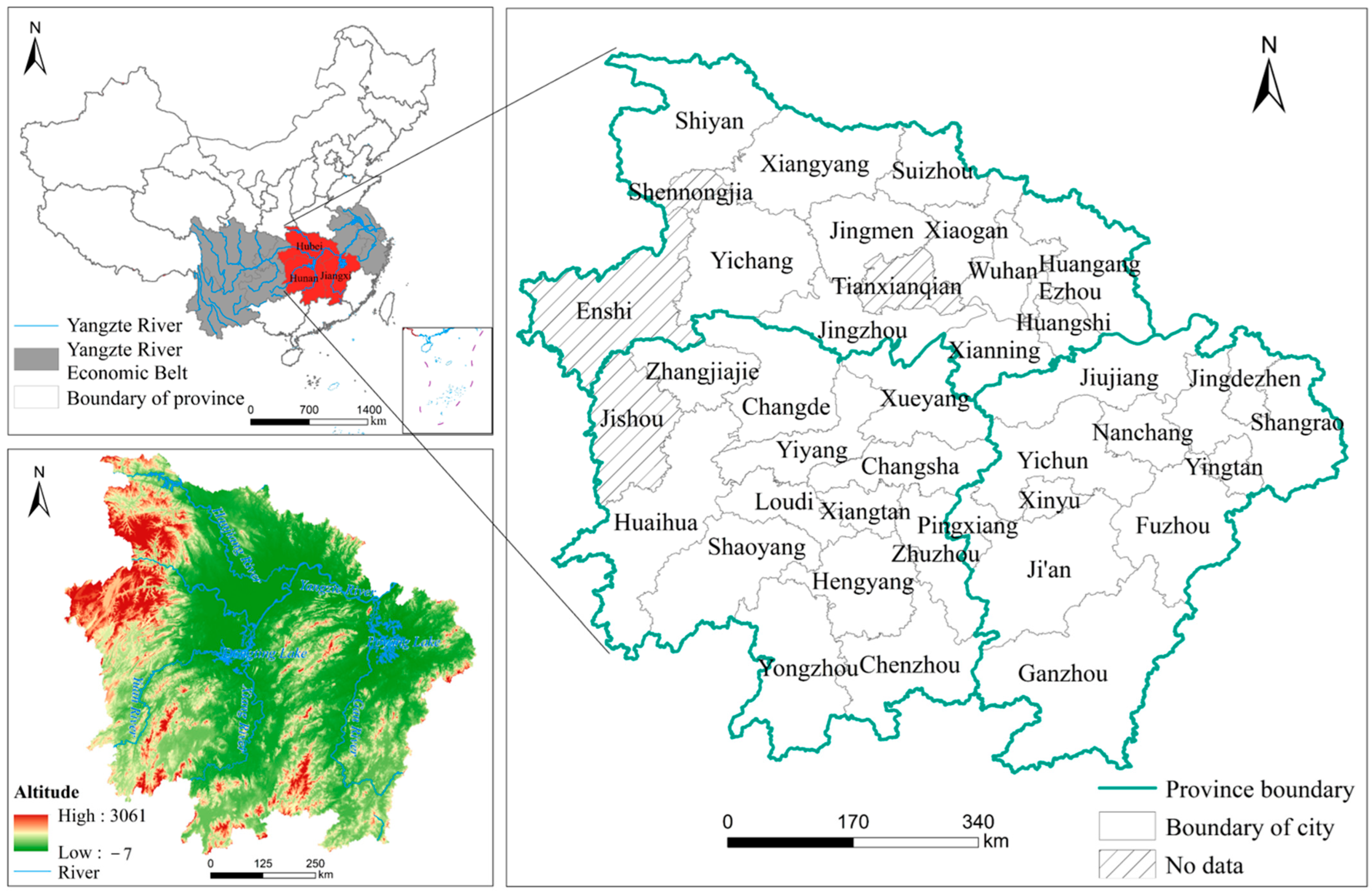
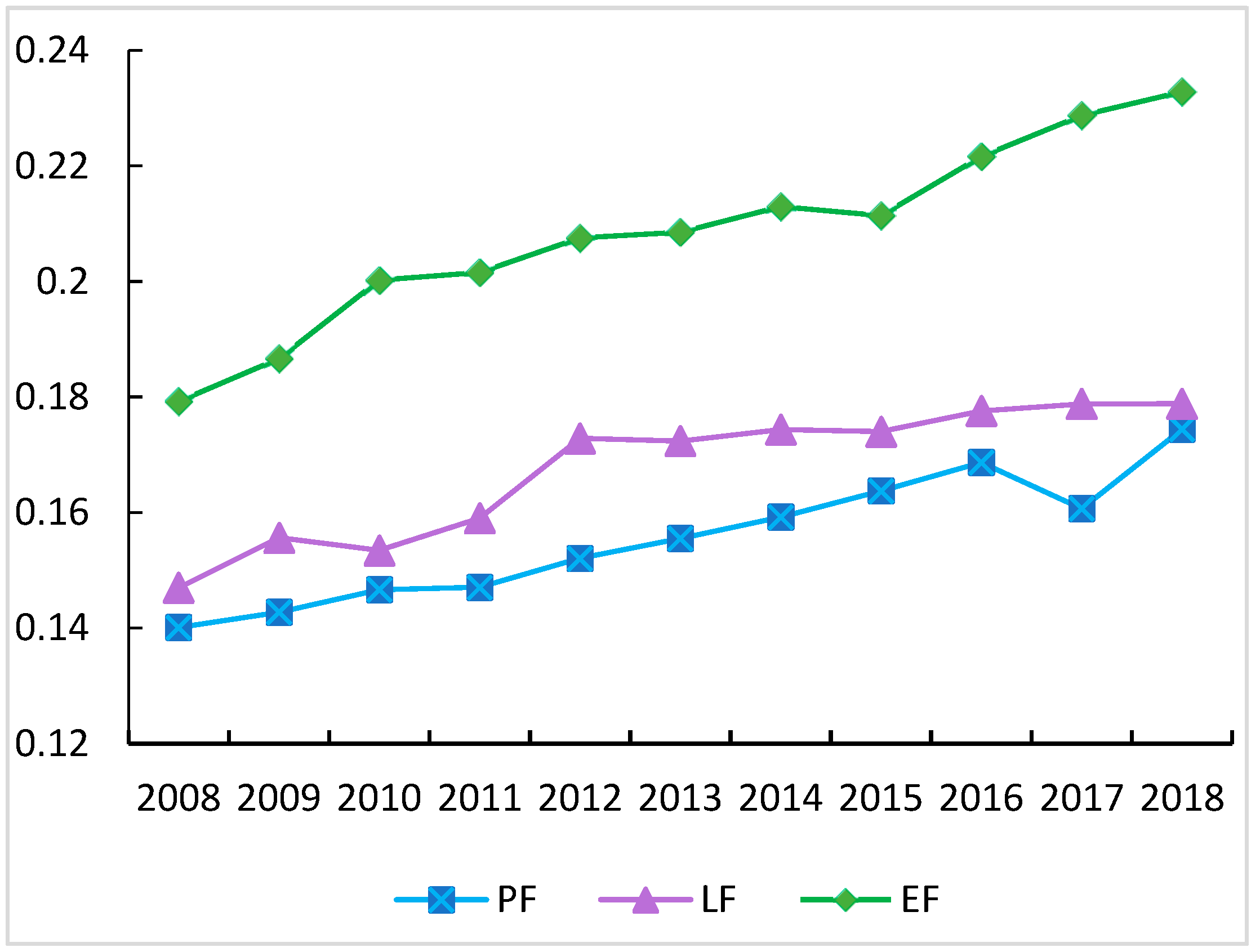
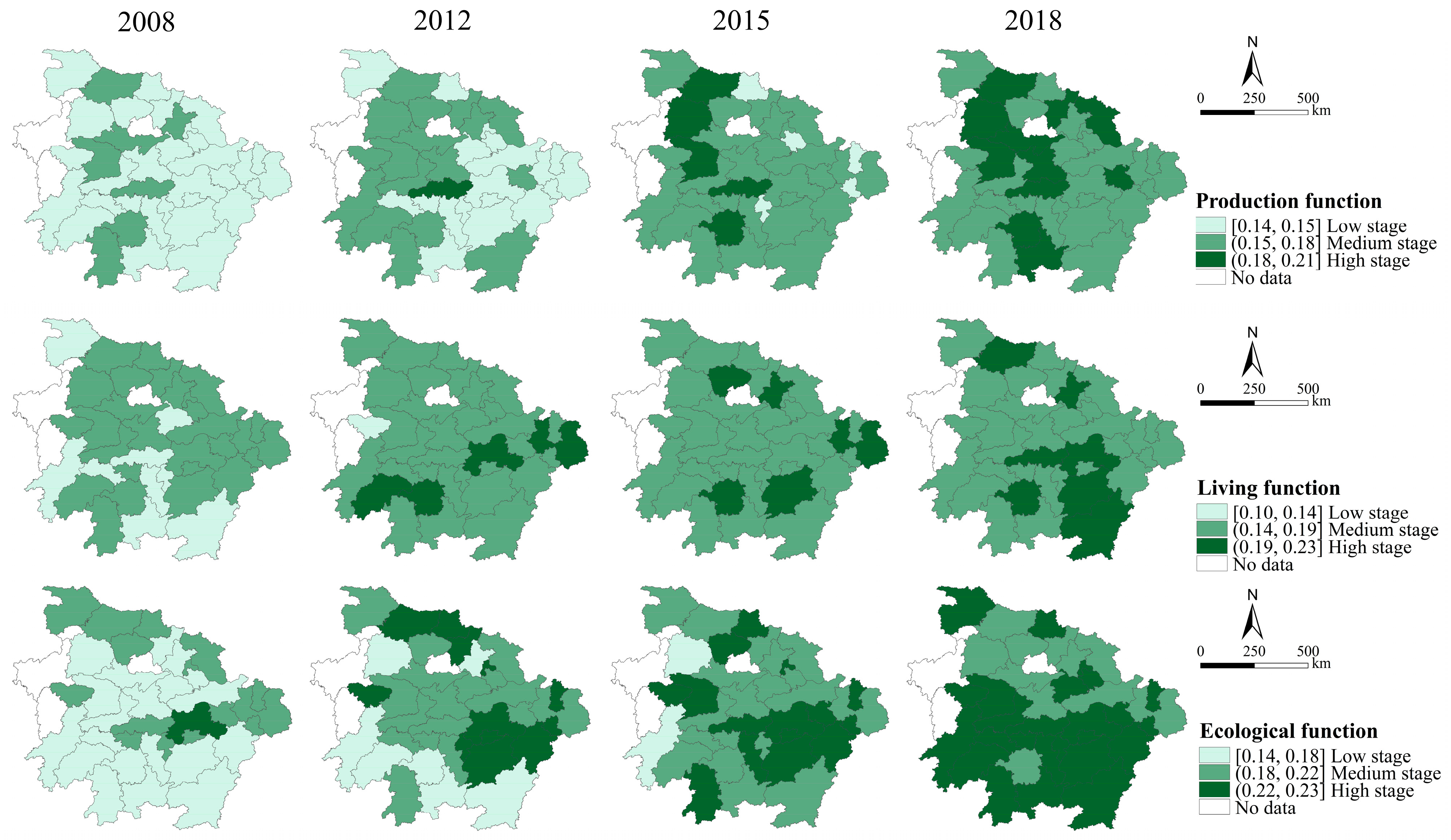
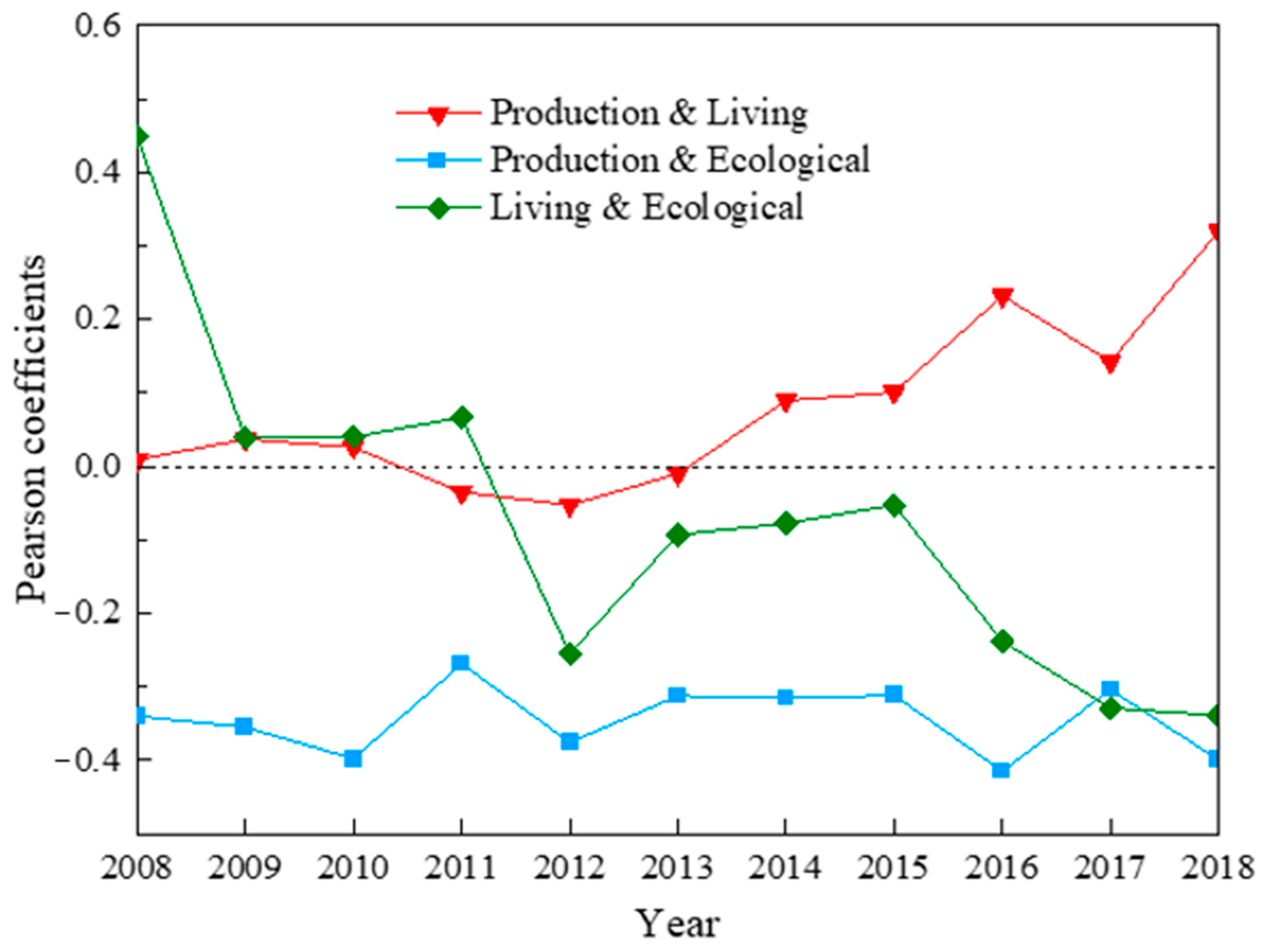



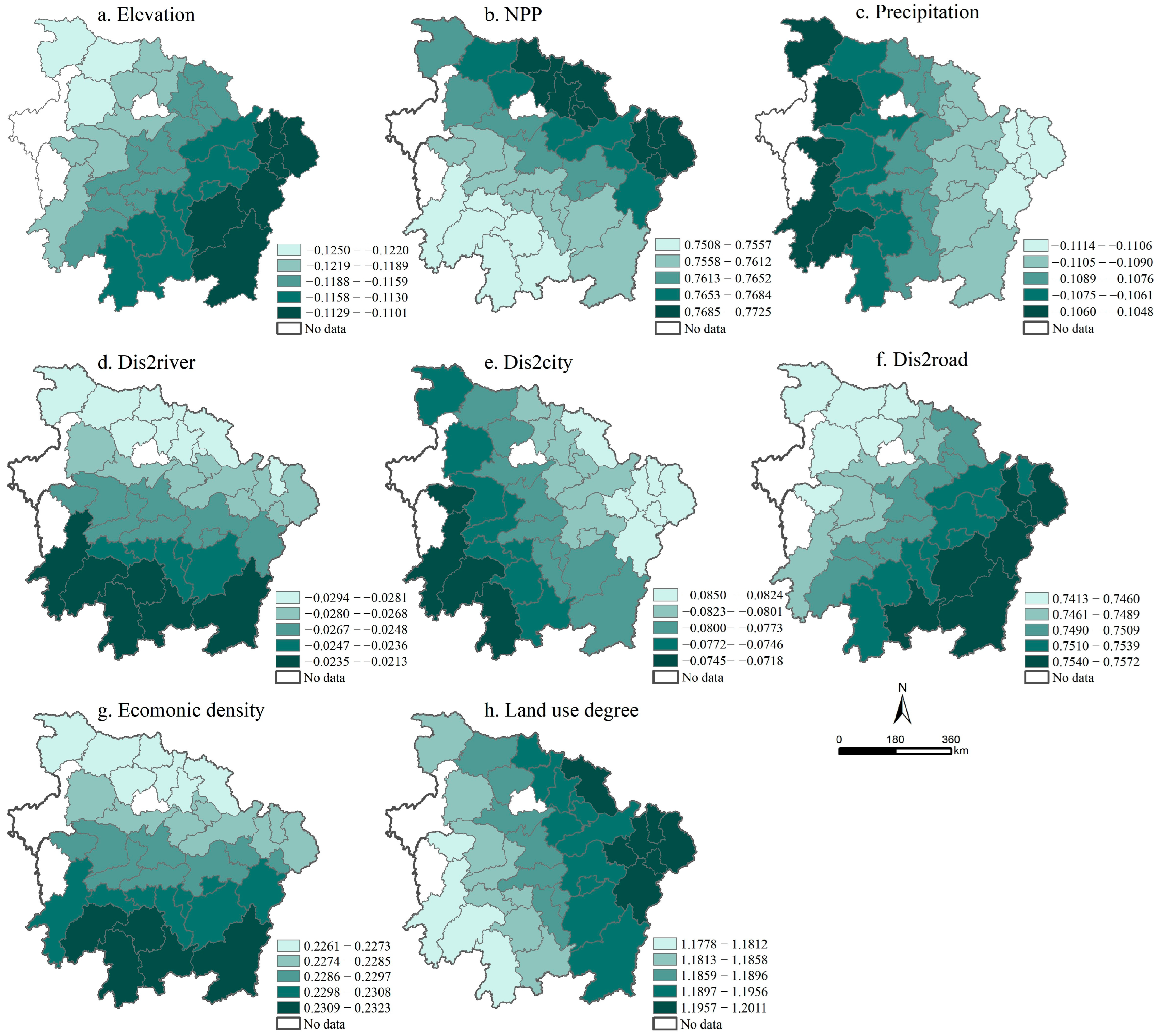
| Functions | Sub-Functions | Indicator | Unit | Weight | Reference |
|---|---|---|---|---|---|
| Production function | Agricultural production function (P1) | Proportion of cultivated land (P11) | % | 0.049 | [39] |
| Total output values of agriculture, forestry, animal husbandry, and fishery (P12) | 108 CNY | 0.048 | [22] | ||
| Non- agricultural production function (P2) | Real estate development investment (P21) | 108 CNY | 0.053 | [17] | |
| The proportion of the added value of the tertiary industry in GDP (P22) | % | 0.051 | [39] | ||
| Number of employees in the tertiary industry (P23) | \ | 0.045 | [22] | ||
| Water used for production and operations (P24) | m3 | 0.053 | [16] | ||
| Per capita GDP (P25) | CNY/ person | 0.048 | [4] | ||
| Living function | Basic living security function (L1) | Per capita daily domestic water consumption (L11) | L | 0.052 | [17] |
| Proportion of construction land (L12) | % | 0.045 | [17] | ||
| Total retail sales of consumer goods (L13) | 108 CNY | 0.041 | [16] | ||
| Social welfare function (L2) | Education expenditure/government expenditure (L21) | % | 0.052 | ||
| Number of hospitals and health institutions (L22) | \ | 0.047 | [22] | ||
| Living quality function (L3) | Population density (L31) | person/ km2 | 0.053 | [39] | |
| Harmless disposal rate of household garbage (L32) | % | 0.052 | [4] | ||
| Ecological function | Environmental pollution function (E1) | Industrial wastewater discharge (E11) | 104 t | 0.052 | [17] |
| Industrial sulfur dioxide emissions (E12) | t | 0.053 | [4] | ||
| Environmental governance function (E2) | Comprehensive utilization rate of industrial solid waste (E21) | % | 0.052 | [4] | |
| Centralized treatment rate of sewage treatment plant (E22) | % | 0.052 | [4] | ||
| Environmental beautification function (E3) | Greenery coverage in built-up areas (E31) | % | 0.052 | [4] | |
| Per capita park green space (E32) | m2/ person | 0.051 | [4] |
| Types | Classification Criteria | ||
|---|---|---|---|
| Positive/Negative Coefficients | Significance | ||
| Synergies | Extremely significant synergy | + | p ≤ 0.01 |
| Significant synergy | + | 0.01 < p ≤ 0.05 | |
| Insignificant synergy | + | p > 0.05 | |
| Trade-offs | Extremely significant trade-off | − | p ≤ 0.01 |
| Significant trade-off | − | 0.01 < p ≤ 0.05 | |
| Insignificant trade-off | − | p > 0.05 | |
| Factors Type | Indicator | Description | Calculation | Reference |
|---|---|---|---|---|
| Natural | Elevation (X1) | Elevation (m) | Extract from DEM | [42] |
| NPP (X2) | Net primary productivity | ArcGIS raster statistics | [42] | |
| Precipitation (X3) | Annual mean precipitation (mm) | ArcGIS raster statistics | [43] | |
| Dis2river (X4) | Distance to river (m) | ArcGIS raster statistics and Euclidean distance | [43] | |
| Socio-economic | Dis2city (X5) | Distance to the provincial capital city (m) | ArcGIS raster statistics and Euclidean distance | [30] |
| Dis2road (X6) | Distance to road (m) | ArcGIS raster statistics and Euclidean distance | [30] | |
| ED (X7) | Economic density (104 CNY/km2) | GDP/total land area | [41] | |
| LUD (X8) | Land use degree (\) | L is the land use degree, Ai is the grade index of the i-th land use type, and Ci is the percentage of the i-th land use type in the total area | [43] |
Disclaimer/Publisher’s Note: The statements, opinions and data contained in all publications are solely those of the individual author(s) and contributor(s) and not of MDPI and/or the editor(s). MDPI and/or the editor(s) disclaim responsibility for any injury to people or property resulting from any ideas, methods, instructions or products referred to in the content. |
© 2024 by the authors. Licensee MDPI, Basel, Switzerland. This article is an open access article distributed under the terms and conditions of the Creative Commons Attribution (CC BY) license (https://creativecommons.org/licenses/by/4.0/).
Share and Cite
Zheng, L.; Wang, Y.; Yang, H.; Bi, Y.; Xu, L.; Wang, Y. Identifying Trade-Offs and Synergies of Production–Living–Ecological Functions and Their Drivers: The Case of Yangtze River Urban Agglomerations in China. Land 2024, 13, 1322. https://doi.org/10.3390/land13081322
Zheng L, Wang Y, Yang H, Bi Y, Xu L, Wang Y. Identifying Trade-Offs and Synergies of Production–Living–Ecological Functions and Their Drivers: The Case of Yangtze River Urban Agglomerations in China. Land. 2024; 13(8):1322. https://doi.org/10.3390/land13081322
Chicago/Turabian StyleZheng, Liang, Yajing Wang, Hui Yang, Yuzhe Bi, Lei Xu, and Ying Wang. 2024. "Identifying Trade-Offs and Synergies of Production–Living–Ecological Functions and Their Drivers: The Case of Yangtze River Urban Agglomerations in China" Land 13, no. 8: 1322. https://doi.org/10.3390/land13081322
APA StyleZheng, L., Wang, Y., Yang, H., Bi, Y., Xu, L., & Wang, Y. (2024). Identifying Trade-Offs and Synergies of Production–Living–Ecological Functions and Their Drivers: The Case of Yangtze River Urban Agglomerations in China. Land, 13(8), 1322. https://doi.org/10.3390/land13081322







